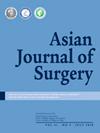腹股沟疝修补术中的医源性血管损伤:发生率、处理和结果的综合分析
IF 3.5
3区 医学
Q1 SURGERY
引用次数: 0
摘要
背景:与腹股沟疝修补术相关的血管性损伤很少有文献记载。本研究旨在对腹股沟疝修复过程中血管损伤的类型、潜在机制、治疗方法、结果和死亡率风险进行全面分析。方法回顾性分析2012 ~ 2023年3988例腹股沟疝修补术患者中13例血管损伤的临床资料。数据包括人口统计信息、损伤类型、手术细节、患者表现、诊断方法、管理策略和结果。通过单变量分析确定导致死亡风险的因素。结果血管损伤发生率为0.075%,其中穿透伤占92.31%,钝性伤占7.69%。常见的机制包括术中剥离、套管针相关损伤和机械网片固定。治疗方法包括吻合、移植、血管内治疗、结扎和保守方法。30天死亡率为23.07%,主要原因是出血性多器官衰竭。晚期并发症包括吻合口再狭窄、移植物动脉瘤、睾丸萎缩和疝气复发。结论腹股沟疝修补术中致缩性血管损伤虽罕见,但存在较高的死亡率和并发症风险。及时识别、干预和长期监测对改善结果至关重要。该研究为疝修补中复杂血管挑战的管理提供了见解,目的是改善患者的预后。本文章由计算机程序翻译,如有差异,请以英文原文为准。
Iatrogenic vascular injuries in inguinal hernia repair: A comprehensive analysis of incidence, management, and outcomes
Background
Iatrogenic vascular injuries associated with inguinal herniorrhaphy are seldom documented. This study sought to provide a thorough analysis of the types, underlying mechanisms, treatment approaches, results, and mortality hazards linked to such vascular injuries during the repair of inguinal hernias.
Methods
Thirteen cases of vascular injury among 3988 inguinal hernia repair patients were retrospectively analyzed from 2012 to 2023. The data included demographic information, injury types, surgical details, patient presentations, diagnostic methods, management strategies, and outcomes. Factors contributing to mortality risk were identified via univariate analysis.
Results
The incidence of vascular injuries was 0.075 %, with 92.31 % being penetrating injuries and 7.69 % being blunt injuries. Common mechanisms included intraoperative dissections, trocar-related injuries, and mechanical mesh fixation. Treatment approaches included anastomosis, transplantation, endovascular therapy, ligation, and conservative methods. The 30-day mortality rate was 23.07 %, primarily due to hemorrhage-induced multiorgan failure. Late complications included anastomotic restenosis, graft aneurysms, testicular atrophy, and hernia recurrence.
Conclusions
Iatrogenic vascular injuries during inguinal herniorrhaphy, though rare, pose significant risks of mortality and complications. Timely identification, intervention, and long-term monitoring are vital for improving outcomes. This study offers insights into managing complex vascular challenges in hernia repair, with the goal of improving patient outcomes.
求助全文
通过发布文献求助,成功后即可免费获取论文全文。
去求助
来源期刊

Asian Journal of Surgery
医学-外科
CiteScore
3.60
自引率
31.40%
发文量
1589
审稿时长
33 days
期刊介绍:
Asian Journal of Surgery, launched in 1978, is the official peer-reviewed open access journal of the Asian Surgical Association, the Taiwan Robotic Surgery Association, and the Taiwan Society of Coloproctology. The Journal is published monthly by Elsevier and is indexed in SCIE, Medline, ScienceDirect, Scopus, Embase, Current Contents, PubMed, Current Abstracts, BioEngineering Abstracts, SIIC Data Bases, CAB Abstracts, and CAB Health.
ASJSUR has a growing reputation as an important medium for the dissemination of cutting-edge developments in surgery and its related disciplines in the Asia-Pacific region and beyond. Studies on state-of-the-art surgical innovations across the entire spectrum of clinical and experimental surgery are particularly welcome.
The journal publishes original articles, review articles, and case reports that are of exceptional and unique importance. The journal publishes original articles, review articles, and case reports that are of exceptional and unique importance.
 求助内容:
求助内容: 应助结果提醒方式:
应助结果提醒方式:


